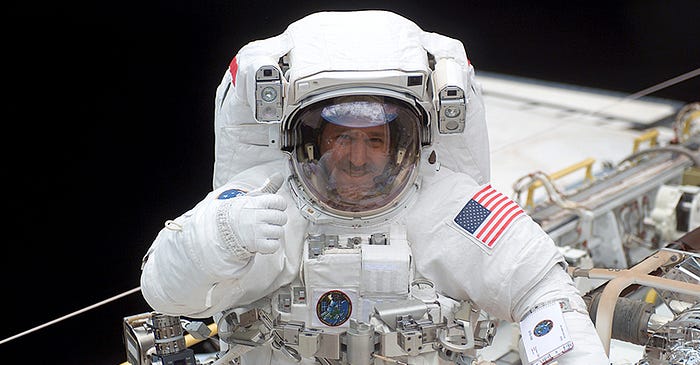
The accomplished astronaut and astrophysicist, John Grunsfeld, spent 58 days in space. He visited the Hubble Space Telescope (HST) three times to service and upgrade the observatory. At the end of my recent Zoom meeting with him, I asked whether he noticed any unusual object in the atmosphere around Earth. He replied that other than classified objects, he did not see anything unusual.
The reason I asked is because the former Director of National Intelligence (DNI), John Ratcliffe, said in March 2021: “… when we talk about sightings, we are talking about objects that have been seen by navy or air force pilots, or have been picked up by satellite imagery, that frankly engage in actions that are difficult to explain, movements that are hard to replicate, that we don’t have the technology for.” The mention of `satellite imagery’ is intriguing because no such data was made public as of yet.
The Galileo Project is analyzing public satellite data from Planet Labs in search for unusual objects. A particularly interesting search area is Antarctica as it offers a white background with negligible human activity. Preliminary examination of satellite data did not reveal any unusual objects there.
The Planet Lab satellites survey large areas of the ground on Earth through discrete snapshots. However, the motion of objects can be inferred from images taken in different colors at slightly different times. The temporal offset between snapshots in different spectral bands, offers a substitute for a full motion video. Any relative change reflects the velocity of the object relative to the velocity of the Planet Lab satellite.
Objects at different elevations would experience different air density and frictional heat release. Deep inside the atmosphere, highly supersonic objects like meteors, would generate a blast wave and be surrounded by a fireball, whereas at a 100 kilometers above the Earth’s surface there would be negligible heat released by their motion.
Earth’s atmosphere is composed of layers, with different composition, temperature, and density. Weather occurs in the lowest layer, the troposphere, which extends from the Earth’s surface to the bottom of the stratosphere and contains three quarters of the atmospheric mass. The height of the troposphere varies between 17 kilometers at the equator and 7 kilometers at the poles. Above it lies the mesosphere, which contains the ozone layer at an altitude around 15–35 kilometers where most of the ultraviolet radiation from the Sun is absorbed. Meter-scale meteors, which hit the Earth once per year, tend to explode into a fireball in the mesosphere, which ranges up to 85 kilometers. Above it lies the thermosphere, which contains the lower part of the ionosphere — where the atmosphere is ionized by sunlight. The Kármán line at 80–100 kilometers is commonly regarded as the boundary between outer space and Earth’s atmosphere.
There are no birds, airplanes or lightning above the Earth’s atmosphere. Any object with an elevation larger than 100 kilometers should be either a space rock or a technological object.
Space tourism which was initiated in 2022 by Virgin Galactic and Blue Origins, targeted an elevation comparable to the boundary with outer space defined by the Theodore van Kármán line. But frequent human trips will extend farther, as SpaceX is planning space tourism in a lunar orbit. The cislunar space between the Earth and the Moon is becoming popular for federal organizations and commercial entities worldwide, including the Copernicus Space Corporation that Frank Laukien and I founded recently.
Extraterrestrial equipment can be distinguished from a terrestrial object, not just by resolving unusual bolts or labels imprinted on its hardware but also based on its motion. As mentioned in the DNI reports in 2021 and 2022, unusual flight characteristics can serve as an indicator of an extraterrestrial origin. Behavioral anomalies include motion at unprecedented speeds or accelerations, not accessible to human-made or natural phenomena, as well as intelligent activity — seeking information or responding to circumstances in ways that cannot be mimicked by familiar objects.
Once an extraterrestrial technological object is identified, the challenge would shift to figuring out its purpose. Knowing the intent of interstellar visitors is of upmost importance in guiding us how to engage with them. This topic will be discussed in my forthcoming book titled Interstellar, to be published by HarperCollins in August 2023.
Small objects are more easily identifiable by a search on the Earth’s surface. This was demonstrated by the recently discovered meteorite, which in terms of its size is in the top 0.2% of the 45,000 meteorites retrieved from Antarctica so far. This rationale motivates missions to study interstellar meteorites, such as the forthcoming expedition planned by the Galileo Project to the Pacific Ocean floor.
As in my case, John Grunsfeld was supported early in his career by John Bahcall, who also made HST a reality. When Grunsfeld was allowed to carry one item with him to the Space Station after Bahcall’s death, John’s wife — Neta Bahcall — gave Grunsfeld their wedding bands. Grunsfeld welded them together and carried the love represented by these bands with him to space in honor of John Bahcall. This was a beautiful gesture of gratitude. After all, Fermi’s paradox suggests that love might be rarer in outer space than it is here on Earth. Irrespective, even if love exists in intergalactic space, it is diluted over time by the accelerated expansion of the Universe.
ABOUT THE AUTHOR

Avi Loeb is the head of the Galileo Project, founding director of Harvard University’s — Black Hole Initiative, director of the Institute for Theory and Computation at the Harvard-Smithsonian Center for Astrophysics, and the former chair of the astronomy department at Harvard University (2011–2020). He chairs the advisory board for the Breakthrough Starshot project, and is a former member of the President’s Council of Advisors on Science and Technology and a former chair of the Board on Physics and Astronomy of the National Academies. He is the bestselling author of “Extraterrestrial: The First Sign of Intelligent Life Beyond Earth” and a co-author of the textbook “Life in the Cosmos”, both published in 2021. His new book, titled “Interstellar”, is scheduled for publication in August 2023.
